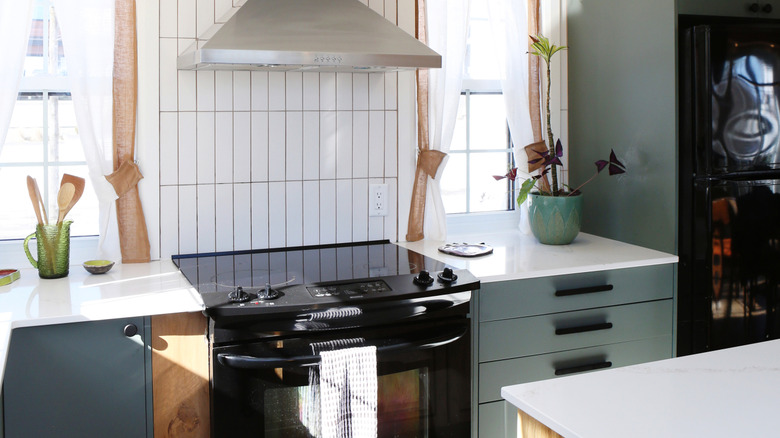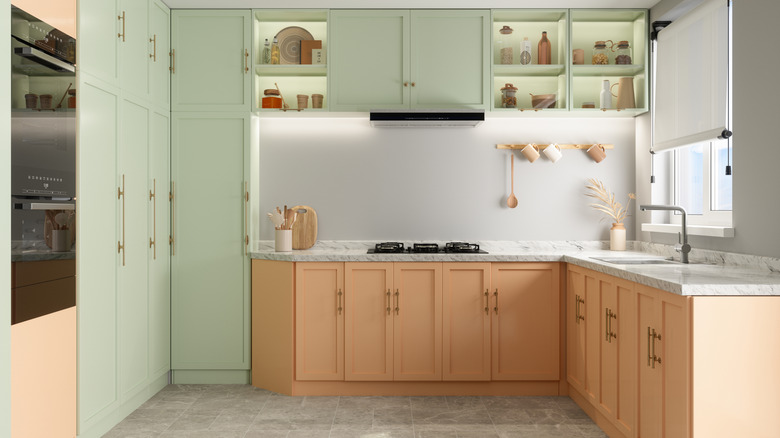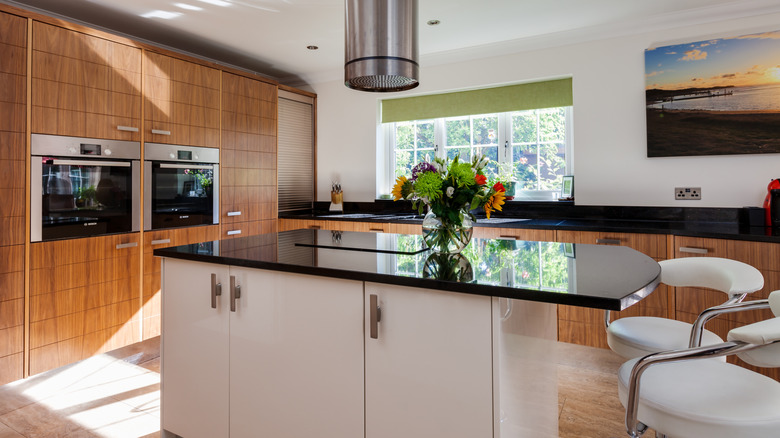Here's The Secret To Making Mixed Kitchen Cabinets Look Cohesive
The term "mixed kitchen cabinets" is something of a retronym — a word invented to make an old or original idea stand out from newer concepts, like "cloth diaper," "analog watch," or "dumbphone." The industrial revolution and resulting 20th-century mass marketing has influenced us so much that "custom cabinetry" now means making minor tweaks to what everyone else has, and "mixed cabinets" are something your whacky sister-in-law does. But fitting a kitchen to your needs and style is about freely making choices even when they break the rules. You can make your kitchen your own, with cohesion and style, by knowing what your version of cohesion and style are. So, the first rule of making mixed kitchen cabinets work is to have a theme or aesthetic in mind. The second rule is to throw out the rules.
House Digest spoke exclusively with our expert design historian, Sarah Bilotta, about how to keep your mixed kitchen cabinets from undermining your aesthetic goals. "Original ideas that may seem out-of-the-box to some tend to outlast trends in the design world," she said. Bilotta explained that mixing cabinets or adding elements like a pantry cabinet for extra kitchen storage can help divide and define larger kitchen spaces but can also make a smaller kitchen appear "cluttered and non-cohesive." That said, Bilotta added that mixing and matching can be timeless when done carefully. "Don't only look to trends; use your own aesthetic sense to chase a chic, crisp, edgy aesthetic."
Keep your kitchen design cohesive with a theme
Because it's such a wide-open concept — almost any combination of cabinetry can be called "mixed cabinets" — pulling everything together can be challenging. When House Digest spoke exclusively with design historian Sarah Bilotta, she told us that mixing cabinets can mean everything from differing paint shades to entirely different structures, styles, and materials. Sometimes, extracting cohesiveness from even the smallest differences can be difficult. "One of my favorite trends is using slightly different shades from the same palette — a darker shade for the lower cabinets, and a lighter one for the upper cabinets," Bilotta said. "A more recent trend that may require a strong design eye is painting your cabinet boxes and doors different tones," she shared, adding that "it is tricky and can make your design look disjointed if not done with care."
This is where establishing a theme up front can be a game-changer. For example, Bilotta explained, "If you want to go for a biophilic look, stick to natural surfaces: unpainted wood, solid stone, and earth tones. If you want to go for a sleek, minimalist contemporary look, focus on cool grays, blacks, and sleek chrome hardware." She finds mood boards helpful to establish your themes and make decisions about using warm versus cool tones, paint or stain, a muted palette or bright hues, and other characteristics as constants. You can also mix kitchen cabinet hardware using one rule from HGTV's Jenn Todryk. Bilotta suggests keeping a list of your theme's primary elements and checking it throughout the installation process to make sure you're not deviating from your vision.
Breaking the rules when mixing kitchen cabinets
Once you've established your working theme, that becomes your new set of rules, replacing much conventional design wisdom. When Sarah Bilotta spoke exclusively with House Digest, she suggested that promoting cohesiveness is a good goal, but the usual shortcuts aren't the only way to get there. "There are so many guidelines that I think are really meant to be broken!" Bilotta said. "For example, if you have stainless steel appliances, your hardware 'has to' be silver or chrome. But, I disagree." The design expert noted that her own kitchen has cherry cabinets, warm brass hardware, and stainless appliances, which don't clash but "create a nice sense of dimension in the space." Mixing and matching hardware is also a good way to visually upgrade cabinets without resorting to paint. And accents shouldn't necessarily be chosen in the service of cohesiveness, since accents are often achieved with contrast, Bilotta pointed out.
As with most things, the degree to which you can break conventional rules depends on your personal experience. Consider, for example, the common advice to pull mixed cabinets together visually by keeping an element the same (hardware and countertops, for example) and limiting the color palette you use. "For more experienced designers, the sky is really the limit," Bilotta said. "I love when designers treat a kitchen island as a piece of furniture unto itself, treating it as a centerpiece with a more dramatic countertop and perhaps a brighter, more obvious color scheme." She suggests using design or photo-editing software to test out ideas so you can make informed decisions about what works and what doesn't, before investing in new cabinets.


